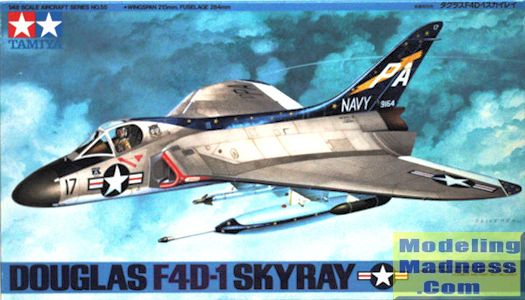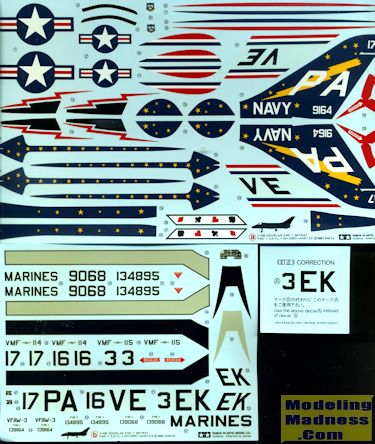Tamiya 1/48 F4D-1 Skyray
|
KIT #: |
61055 |
|
PRICE: |
Currently $43.00 SRP
|
|
DECALS: |
Three options |
|
REVIEWER: |
Scott Van Aken |
|
NOTES: |
|

The Douglas F4D Skyray (later redesignated
F-6 Skyray) was an
American carrier-based supersonic
fighter/interceptor built by the Douglas Aircraft Company. Although it
was in service for a relatively short time and never entered combat, it was
notable for being the first carrier-launched aircraft to hold the world's
absolute speed record, at 752.943 mph, and was the first United States Navy
and United States Marine Corps fighter that could exceed Mach 1 in level
flight. It was the last fighter produced by the Douglas Aircraft Company
before it merged with McDonnell Aircraft and became McDonnell Douglas. The
F5D Skylancer was an advanced development of the F4D Skyray that did not go
into service. 420 aircraft were built and eventually operated with nearly
two dozen USN and USMC squadrons. Typical of most Naval aircraft of the
1950s, its active service was relatively short, such was the pace of
aircraft development during the time.
 Aside from Lindberg's prototype Skyray kit of the 1950s, this has been the
only other 1/48 F4D-1 to be produced. Fortunately, Tamiya does excellent
work on its kits and this 1998 offering will unlikely be eclipsed. One thing
that has changed is that the kit is considerably more expensive now than
when your editor purchased his in the late 1990s. There are a few build
articles in the archives, but no preview so I though it was time to provide
it.
Aside from Lindberg's prototype Skyray kit of the 1950s, this has been the
only other 1/48 F4D-1 to be produced. Fortunately, Tamiya does excellent
work on its kits and this 1998 offering will unlikely be eclipsed. One thing
that has changed is that the kit is considerably more expensive now than
when your editor purchased his in the late 1990s. There are a few build
articles in the archives, but no preview so I though it was time to provide
it.
The main parts of the kit are divided into upper and lower wing/fuselage
sections with a separage vertically divided nose. Into this nose goes a
nicely done cockpit tub that sits atop the nose gear well. The cockpit
consists of the usual instrument panel, control stick and rudder pedals with
a separate anti-glare panel. The seat is a five piece construct. A pilot
figure is supplied. No nose weight is indicated.
The wing build is somewhat complex. First holes need to be opened if
carrying all the various pylons. At the back of the fuselage are a set of
connected trimmers that can be posed in various positions. The kit provides
an option for folding wings so the wing tips are separate pieces. There are
sections of airframe that you can see in the fold joins. An engine
compressor section is attached to the inner main gear well pieces and this
section also includes the intake blanking plate. There are separate slats
that can be posed extended. Intakes are a single piece that helps to lock
the nose section in place.
In the back is a three piece exhaust section that slides into the back of
the fuselage so you can leave this off until after painting. All the landing
gear are suitable complex with various retraction rods and struts. All the
wheels are two halves and these can be installed after painting as well. In
the back of the fuselage is a tail bumper and an a-frame tailhook. The
fin/rudder is in left and right halves and slots into the upper rear
fuselage. The instructions offer a complete guide when it comes to modeling
the wings folded or extended. There are different parts to use in either
case and some modifications needed for extended wings. A separate windscreen
and canopy are provided.
For things under the wings/fuselage you have a pair of large fuel tanks,
Sidewinder missiles and pylons as well as what is called a NAVPAC for under
the fuselage centerline. Outboard are rocket pods which can be displayed
with their aerodynamic nose and tail caps if you so wish.
Instructions are quite good and only offer Tamiya paint numbers for color
references. All three markings options are in light gull grey and white. The
box art plane is from VF(AW)-3 based at NAS North Island with the blue areas
with gold stars. These are all supplied as decals. The other two are USMC
planes. One is VMF(AW)-114 and the other is VMF(AW)-115. There are
aftermarket decals if you wish to do other schemes. The decals are nicely
printed and while a tad thick, should cause few issues in placement. Both
black and grey wing walk panels and nose anti-glare panels are provided.
Those who have built this kit have all commented
on how trouble-free the experience was for them. Since it is a Tamiya kit, I
would expect that as you are paying for some of the best kit engineering around.
https://en.wikipedia.org/wiki/Douglas_F4D_Skyray
August 2015
Review kit courtesy your editor.
If you would like your product reviewed fairly and fairly quickly, please contact the editor
or see other details in the
Note to
Contributors.
Back to the Main Page
Back to the Previews Index Page


 Aside from Lindberg's prototype Skyray kit of the 1950s, this has been the
only other 1/48 F4D-1 to be produced. Fortunately, Tamiya does excellent
work on its kits and this 1998 offering will unlikely be eclipsed. One thing
that has changed is that the kit is considerably more expensive now than
when your editor purchased his in the late 1990s. There are a few build
articles in the archives, but no preview so I though it was time to provide
it.
Aside from Lindberg's prototype Skyray kit of the 1950s, this has been the
only other 1/48 F4D-1 to be produced. Fortunately, Tamiya does excellent
work on its kits and this 1998 offering will unlikely be eclipsed. One thing
that has changed is that the kit is considerably more expensive now than
when your editor purchased his in the late 1990s. There are a few build
articles in the archives, but no preview so I though it was time to provide
it. 